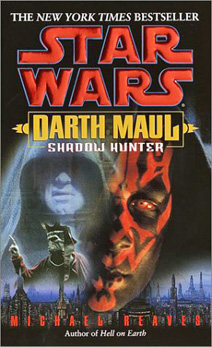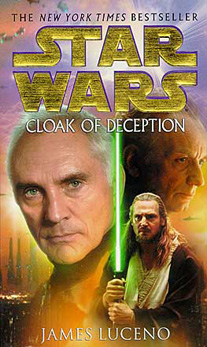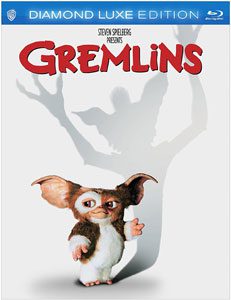Welcome to a new feature where I revisit old “Star Wars” novels when inspired by new works. The inspiration for this first entry is James Luceno’s “Darth Plagueis,” which reads like a fascinating history book and has two entire other novels take place within it while also overlapping with most of “Episode I: The Phantom Menace.”
Those two novels, which take place immediately before Episode I, were both published in 2001: Luceno’s “Cloak of Deception” and Michael Reaves’ “Darth Maul: Shadow Hunter.” A lot of fans have mentioned that “Darth Plagueis” made them want to re-read “Cloak of Deception,” which Luceno has called a “companion piece” to “Darth Plagueis,” and I was in the same boat. Part of the reason is that I didn’t remember a darn thing about “Cloak.”
Whereas Luceno was given free reign in this new novel to explore Plagueis and Sidious in-depth and incorporate other novels and “The Clone Wars,” he was handcuffed on “Cloak,” where he only had Episode I to draw from. “Plagueis” shows Sidious’ machinations on a broad scale, like a galactic game of Risk, but “Cloak” specifically tackles the Senate controversy about whether the Trade Federation should be taxed by the Republic.
I’m not too familiar with political thrillers, but I suspect the “Star Wars” prequel era does a decent job with this genre. Although it’s certainly not for every fan — and those fans have made that clear — I think “Star Wars” is vast enough to include a lot of genres, and I’ve warmed up to the political intrigue in the last decade largely because I understand it better now.
In “Cloak,” a lot pages are given to Captain Cohl, a Nebula Front mercenary, and we also get a bit of Qui-Gon’s obsession with tracking down Cohl. But mostly it’s about Cohl because Luceno was more comfortable using his own character rather than going too far with the movie characters. Scenes with movie characters are played safe: There are also a lot of conversations that mirror the Neimoidians’ chats with Palpatine in Episode I where they lament “We should not have made this bargain.” And there are some good conversations between Palpatine and Chancellor Valorum.

“Darth Maul: Shadow Hunter” is a more memorable novel, as Maul wordlessly (but not thoughtlessly) stalks his prey — a Jedi-hating freelancer, his droid companion, and two Jedi — through the underlevels of Coruscant, leaving a swath of bodies in his wake. (Mirroring the first film’s “Death Star plans” maguffin, Maul’s targets hold proof of the Naboo invasion plans.) As with a lot of “Star Wars” novels and comics with a villain in the title, the author seeks to make the story more accessible by introducing new heroes who are pursued by the villain. Hence, we root for the heroes while also appreciating the villain’s skill and inevitable victory (“Darth Plagueis’ ” ability to break this pattern and really zero in on the villain is part of its brilliance).
“Shadow Hunter’s” most intriguing character is I-Five, a droid who behaves like a sentient; he’s an equal to Lorn Pavan, not his assistant. I-Five is the good-guy answer to the money-grubbing IG-88 and 4-LOM from the bounty hunter scene in “Empire Strikes Back.” Reaves would go on to do better work in five subsequent novels that feature I-Five and Lorn Pavan’s son, the Jedi Jax Pavan, in the “MedStar” duology and the “Coruscant Nights” trilogy. There’s also a fourth “Coruscant Nights” book in the works.
“Cloak of Deception” is skippable for those who aren’t into political intrigue. Darth Maul fans (and aren’t we all?) will want to read “Shadow Hunter” (which recently got a paperback re-release) for the Maul action, and as a bonus you’ll get the start of the I-Five and Pavan family storyline, which only ramps up from here.
Next up in my “flashback” series, inspired by “The Clone Wars’ ” current portrayal of Dathomir and its resident Nightsisters and Nightbrothers (including Assaj Ventress, Savage Opress and Darth Maul), I plan to re-read the novel that introduced these elements, Dave Wolverton’s “The Courtship of Princess Leia” (1994).


